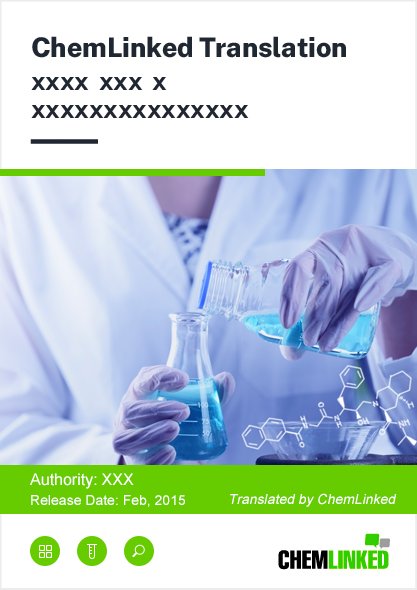Chinese C&L Inventory defines the core scope of hazardous chemicals control in China. The current latest version of this inventory was released in 2002 by the state top work safety authority, SAWS, which has been known to the public as the 2002 Catalogue of Hazardous Chemicals. The 2002 Catalog was once released to support the implementation of the 2002 edition of Regulations on the Control over Safety of Hazardous Chemicals (State Council Decree 344) and the 2002 edition of Measures for the Administration of Hazardous Chemicals Registration (SETC order 35).
In February 2011, SAWS substantially revised State Council Decree 344 and replaced it with Decree 591. Therefore, the revision and expansion work on an updated inventory is becoming urgent. On the other side of the coin, it is also one vital goal set in Decree 591 to map out a more distinct regime of domestic hazardous chemicals. Officials from SAWS confirmed that a brand new version will provide more technical support and guarantee for the implementation of Decree 591 and a series of its derivative rules regarding control of hazardous chemicals in China.
As stipulated in Article 3 of Decree 591,“hazardous chemicals” included in the upcoming new inventory refer to toxic chemicals and other chemicals which have properties of poison, corrosion, explosion, burning and combustion supporting, etc. and cause damage to the human body, facilities and the environment. The new inventory shall be identified based on the inherent hazard properties of chemicals in line with relevant national classification criteria, and shall be published and adjusted in time in the joint consent of 10 governmental departments led by the SAWS. The other nine ministries are respectively, MIIT (Ministry of Industry and Information Technology), MPS (Ministry of Public Security), MEP (Ministry of Environmental Protection), MOH (Ministry of Health), AQSIQ (Administration of Quality Supervision, Inspection and Quarantine), MOT (Ministry of Transport), MOR (Ministry of Railways), CAAC (Civil Aviation Administration) and MOA (Ministry of Agriculture).
The 2002 Catalogue currently lists 3,815 hazardous chemicals classified in 7 hazard categories and 19 divisions (sub-categories). The inventory presents four main columns: domestic code of dangerous goods, Chinese chemical name, synonym and UN number. Companies should notice however that existing classification on the 2002 catalogue is not fully identical to that of GB 13690-2009, the national compulsory standard of GHS-compliant chemical classification. So before the actual release of the new inventory, GB 13690-2009 will remain the sole criteria in identifying the chemical hazard classification.
Concrete hazard categories in the 2002 Catalogue are described as follows:
The 1st Category: Explosives (Division 2 is missing)
Division 1: Substances and articles that have a hazard of mass detonation
Division 3: Substances and articles that have a hazard of fire and either a minor blast or minor projection or both, but of no mass explosion hazard
Division 4: Substances and articles that present no significant hazard
The 2nd Category: Compressed gases and liquefied gases
Division 1: Flammable gases
Division 2: Non-flammable gases
Division 3: Toxic gases
The 3rd Category: Flammable liquids
Division 1: Liquids of low flash point
Division 2: Liquids of medium flash point
Division 3: Liquids of high flash point
The 4th Category: Flammable solids, articles of spontaneous combustion and articles which in contact with water emit flammable gases
Division 1: Flammable solids
Division 2: Articles liable to spontaneous combustion
Division 3: Articles which in contact with water emit flammable gases
The 5th Category: Oxidizing substances and organic peroxides
Division 1: Oxidizing substances
Division 2: Organic peroxides
The 6th Category: Toxic and infectious articles
Division 1: Toxics
The 8th Category: Corrosives
Division 1: Corrosives presenting acidic properties
Division 2: Corrosives presenting alkalinous properties
Division 3: Other corrosives
News from the National Registration Center for Chemicals of the SAWS (NRCC-SAWS) predicted in 2011 that there would be more than 7,000 chemicals included in the ongoing new C&L Inventory. However, according to the latest official news from NRCC-SAWS on the June 6th REACH24H Milan Workshop in 2012, the new Inventory is expected to contain between 4,000 and 5,000 hazardous chemicals, integrating the following three parts based on the foundation of the 2002 version:
Hazardous chemicals listed in the national standard GB 12268-2005, List of Dangerous Goods (about 3500 chemicals)
Chemicals listed in the Inventory of Chinese Highly Toxic Chemicals (about 150 chemicals)
Other hazardous chemicals which are not listed in GB 12268 but identified and announced by relevant national departments.
The upcoming inventory will codify hazardous chemicals by the universal UN number in replace of the old domestic code of dangerous articles. More important, several columns will be added to help define the distinct hazard properties of chemicals, like English chemical name, English synonym, CAS number, hazard category, hazard statements (like H-phrases and P-phrases in the EU CLP regulation) , the GB 13690 based GHS pictogram and signal word, etc. As a result, the new Catalogue is expected to offer more comprehensive classification and labelling instruction for the hazardous chemical industry.





 Original regulatory document
Original regulatory document